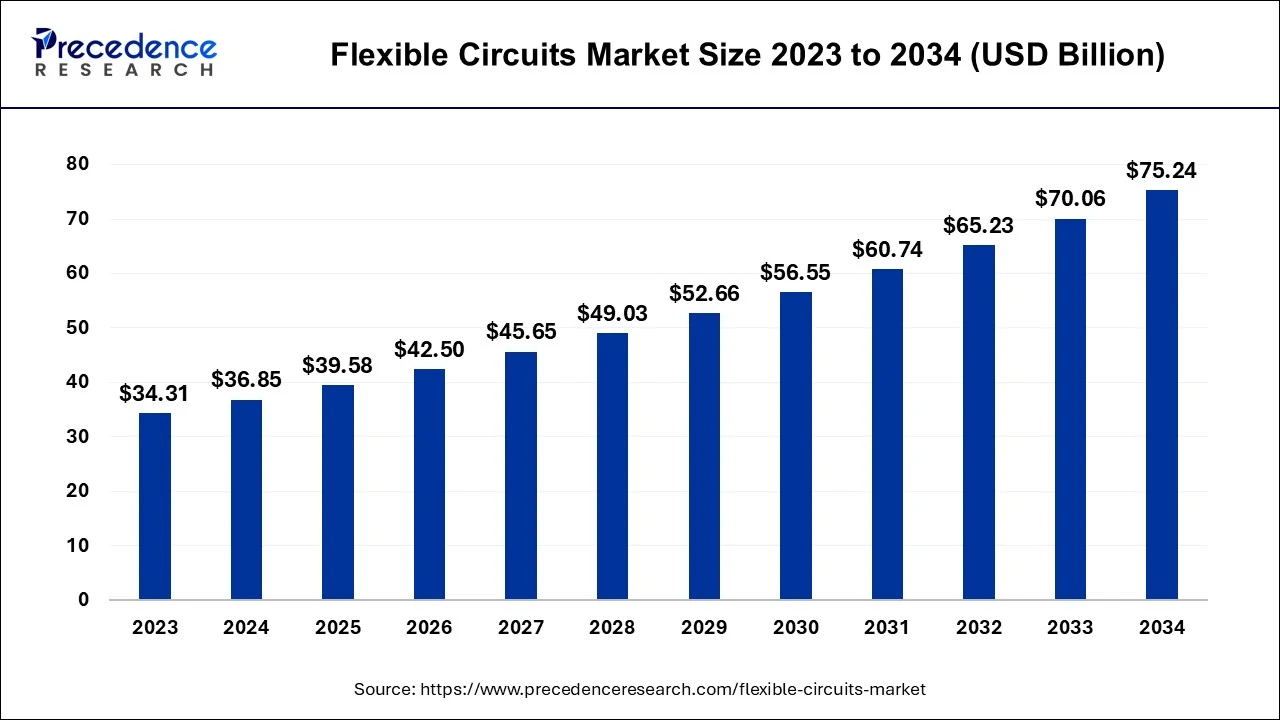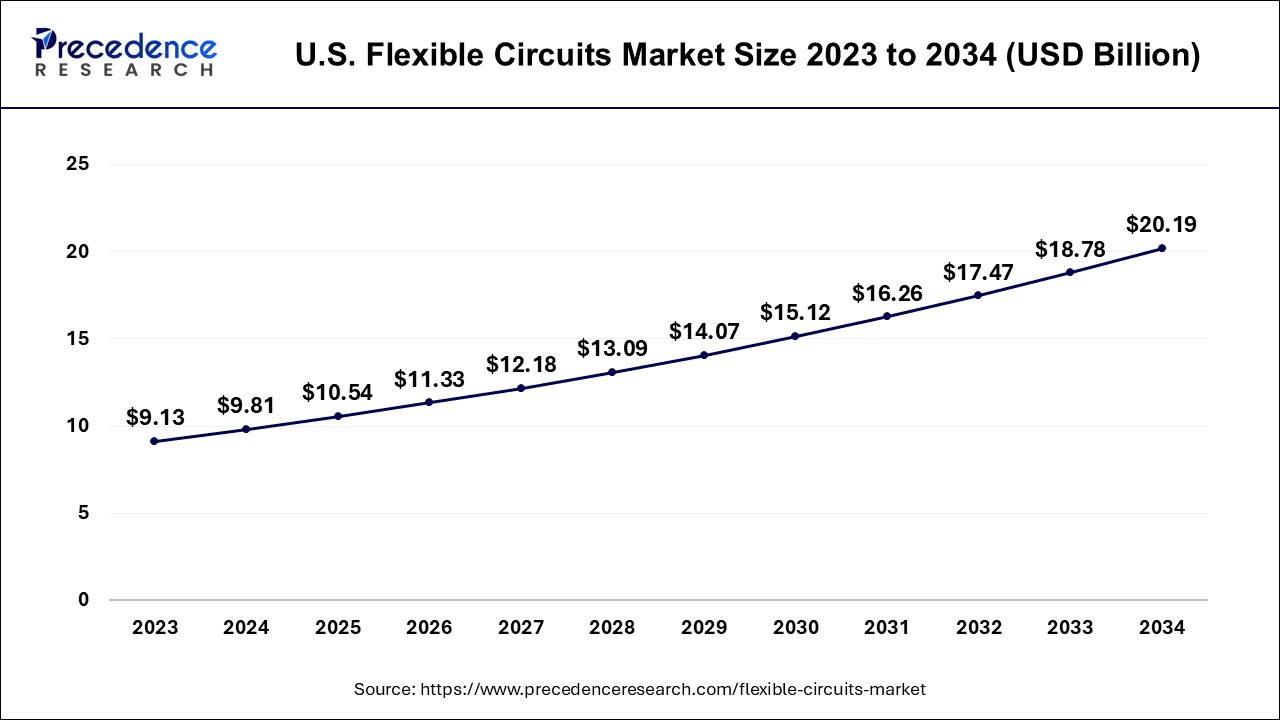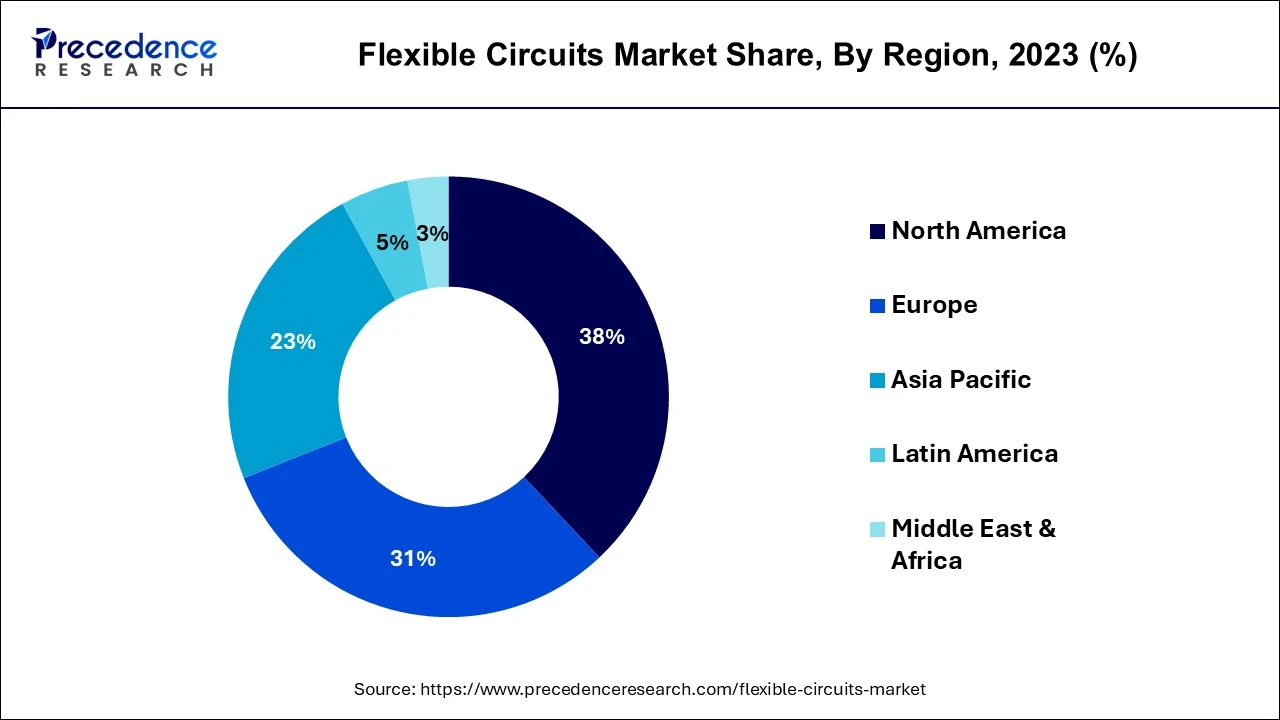What is the Flexible Circuits Market Size?
The global flexible circuits market size is estimated at USD 39.58 billion in 2025 and is anticipated to reach around USD 75.24 billion by 2034, growing at a CAGR of 7.40% between 2025 and 2034.

Market Highlights
- North America contributed more than 38% of revenue share in 2025.
- Asia Pacific is estimated to expand the fastest CAGR between 2025 and 2034.
- By application, the consumer electronics segment has held the largest market share of 48% in 2025.
- By application, the automotive segment is anticipated to grow at a remarkable CAGR of 8.2% between 2025 and 2034.
- By material, the base material segment generated over 42% of revenue share in 2025.
- By material, the conductor material segment is expected to expand at the fastest CAGR over the projected period.
- By construction, the single-sided flex circuits segment had the largest market share of 37% in 2025.
- By construction, the multi-layer flex circuits segment is expected to expand at the fastest CAGR over the projected period.
Market Size and Forecast
- Market Size in 2025: USD 39.58 Billion
- Market Size in 2026: USD 42.50 Billion
- Forecasted Market Size by 2034: USD 75.24 Billion
- CAGR (2025-2034): 7.40%
- Largest Market in 2024: North America
- Fastest Growing Market: Asia Pacific
Market Overview
The flexible circuits market is a dynamic segment of the electronics industry, characterized by using flexible substrates like polyimide or polyester. Flexible circuits are lightweight, compact, and malleable electronic components that conform to various shapes. They are prized for their space-saving attributes and durability, making them a preferred choice in consumer electronics, automotive, aerospace, and medical devices.
The market's expansion is fueled by the rising need for compact, lightweight electronic solutions, complemented by material and manufacturing advancements, ensuring a promising future for flexible circuits in various industries. The flexibility of these circuits provides design versatility, and their adoption is expected to continue expanding across various industries.
Flexible Circuits Market Growth Factors
- The growing appetite for smaller and lighter electronic devices across various industries, from wearables to IoT devices, fuels the expansion of flexible circuits. This trend reflects the consumers' desire for portable, unobtrusive technology.
- The rapid evolution of smartphones, tablets, wearables, and other portable gadgets has created a robust market for flexible circuits. These circuits enable sleek and flexible device designs while ensuring reliable electrical connections.
- The automotive sector is leveraging flexible circuits for in-car electronics, infotainment systems, and advanced driver-assistance systems. These circuits offer the flexibility to fit into unique spaces within vehicles, enhancing design options and functionality.
- Collaborating with other companies, research institutions, and industry experts fosters innovation and provides access to shared resources, accelerating the pace of technological advancements in flexible circuit design and manufacturing.
- Developing and promoting eco-friendly materials and manufacturing processes can help meet the growing demand for sustainable electronic solutions.
- Exploring emerging markets and expanding the customer base beyond established regions provides opportunities for growth and diversification in the flexible circuits market. Understanding regional needs and trends is essential for success in these markets.
- The industry trend towards smaller, more compact electronic devices drives ongoing innovation in flexible circuit design. Smaller form factors require greater flexibility and miniaturization, pushing the boundaries of what is achievable.
Market Scope
| Report Coverage | Details |
| Market Size in 2025 | USD 39.58 Billion |
| Market Size in 2026 | USD 42.50 Billion |
| Market Size by 2034 | USD 75.24 Billion |
| Growth Rate from 2025 to 2034 | CAGR of 7.40% |
| Largest Market | North America |
| Base Year | 2025 |
| Forecast Period | 2025 to 2034 |
| Segments Covered | Application, Material, Construction, and Region |
| Regions Covered | North America, Europe, Asia-Pacific, Latin America, and Middle East & Africa |
Market Dynamics
Drivers
Miniaturization and consumer electronics
Miniaturization is a key driver surging the market demand for flexible circuits. As consumer and industrial electronics continue to shrink in size and weight, traditional rigid PCBs struggle to keep pace. Flexible circuits, due to their bendable and adaptable nature, offer a compelling solution. They allow manufacturers to create smaller, lighter, and more compact electronic devices while maintaining functionality. This trend is particularly evident in the smartphone industry, where consumers demand increasingly sleek and lightweight designs. Flexible circuits are integral in achieving these design goals, and their ability to fit into tight spaces and conform to various form factors has revolutionized product design and manufacturing across various sectors.
These circuits have become a staple in the design of such devices, enabling curved displays, flexible components, and robust connections. As consumers seek the latest innovations and cutting-edge technology, consumer electronics manufacturers must turn to flexible circuits to meet these demands. This surge in consumer electronics drives both the adoption and continuous development of flexible circuit technology, establishing it as a pivotal component in the ever-evolving world of portable and consumer-oriented electronic products.
Restraint
Signal integrity challenges and high production costs
Signal integrity issues can pose significant restraints on the flexible circuits market. Maintaining the integrity of data and power transmission within flexible circuits is a complex task, particularly as these circuits need to accommodate bending and flexing. Signal degradation can lead to data loss, electrical noise, and reduced performance. Ensuring signal integrity demands rigorous design and testing methodologies, which can increase production time and costs. Additionally, in high-frequency applications, signal integrity challenges can be even more pronounced, limiting the application of flexible circuits in critical industries like telecommunications and high-speed data transmission.
The flexible circuits market faces limitations due to high production costs. Developing cost-effective manufacturing processes for flexible circuits remains a primary concern. The intricate design and specialized materials required for flexible circuits can be expensive. Achieving the necessary precision, consistency, and reliability in production adds to the overall cost. These factors can lead to a higher price point for flexible circuit solutions, making them less accessible for some applications and potentially limiting their adoption, particularly in cost-sensitive industries. Reducing production costs while maintaining quality is a continual challenge for the flexible circuits market to address market demand effectively.
Opportunity
IoT expansion and sustainability initiatives
The flexible circuits market experiences a substantial boost in demand due to the widespread adoption of Internet of Things (IoT) devices. With IoT applications expanding into various sectors, flexible circuits become indispensable components, offering the required flexibility and adaptability for these smart devices. Their crucial role in connecting and powering IoT devices is evident as the IoT ecosystem continues to grow, further driving demand in the flexible circuits market.
The adaptability of flexible circuits allows them to conform to the unique shapes and spaces within IoT devices, enabling the miniaturization and integration of electronics. As IoT applications diversify, including smart home devices, wearable technology, and industrial sensors, the demand for flexible circuits grows exponentially. Their flexibility and versatility make them an ideal choice for connecting and powering these intelligent devices, further driving market demand.
The global shift toward sustainability and eco-friendliness is a significant driver for the flexible circuits market. As environmental concerns intensify, manufacturers are increasingly adopting green and sustainable materials in their production processes. Flexible circuits, when designed with eco-friendly materials and manufacturing techniques, align with these sustainability initiatives.
Moreover, the durability and longevity of flexible circuits reduce electronic waste and contributes to a more sustainable electronics ecosystem. As environmental regulations and consumer preferences emphasize sustainability, the adoption of eco-friendly flexible circuits is gaining momentum, generating heightened demand in a market that prioritizes both performance and environmental responsibility.
Regional Insights
Application Insights
According to the application, the consumer electronics segment has held of 48% revenue share in 2025. In the flexible circuits market, consumer electronics encompass devices such as smartphones, wearables, and tablets. Trends in this segment include the demand for thinner and more lightweight devices, where flexible circuits play a pivotal role in achieving sleek designs. As consumers seek innovative and portable technology, flexible circuits enable compact and durable solutions. Additionally, the market trend involves integrating flexible circuits into foldable screens and advanced displays, catering to the growing demand for flexible and immersive consumer electronic experiences.
The automotive sector segment is anticipated to expand at a significant CAGR of 8.5% during the projected period. Within the automotive sector, flexible circuits are employed for infotainment systems, Advanced Driver Assistance Systems (ADAS), and electronic control units (ECUs). The trend in this application involves the integration of flexible circuits for space-saving and weight reduction.
Automakers are increasingly using flexible circuits to streamline vehicle electronics and achieve better designs, enhancing vehicle safety and user experiences. As electric and autonomous vehicles gain prominence, the role of flexible circuits in enabling advanced automotive technologies continues to grow.
Material Insights
Based on the material, the base material segment held the largest share of 42% in 2025. In the flexible circuits market, the base material refers to the substrate upon which the flexible circuit is constructed. It serves as the foundation for the entire circuit and must possess attributes like flexibility, durability, and good thermal performance. Manufacturers are increasingly adopting advanced materials such as polyimide, polyester, and liquid crystal polymer to enhance the base material's properties, enabling thinner and more resilient flexible circuits. Additionally, sustainable and eco-friendly base materials are gaining prominence, aligning with the growing demand for environmentally responsible electronics.
On the other hand, the conductor materials segment is projected to grow at the fastest rate over the projected period. Conductor materials in flexible circuits refer to the conductive elements that transmit electrical signals. Key trends involve the use of materials with high conductivity and flexibility. Copper remains a primary choice due to its excellent electrical properties. However, advancements in nanomaterials and conductive inks are expanding the possibilities, allowing for thinner and more flexible conductors, reducing weight and improving performance in various applications, including IoT devices and wearables.
Construction Insights
In 2025, the single-sided flex circuits segment had the highest market share of 37% based on the end user. Single-sided flex circuits are designed with a single conductive layer. They are highly flexible and often used in applications where bending or twisting is required. Trends in the flexible circuits market show an increasing demand for single-sided flex circuits due to their lightweight, compact design and cost-efficiency. Their use is prevalent in consumer electronics, automotive, and healthcare devices, as they offer space-saving solutions while maintaining reliability.
The multi-layer flex segment is anticipated to expand at the fastest rate over the projected period. Multi-layer flex circuits consist of multiple conductive layers separated by insulating layers. These circuits are known for their enhanced functionality and versatility. In the flexible circuits market, the trend is shifting towards multi-layer flex circuits, especially in high-end electronics and complex applications like aerospace and telecommunications. The demand for increased functionality and miniaturization in electronic devices is driving this trend, as multi-layer flex circuits offer the necessary flexibility while accommodating a higher level of complexity and interconnections.
Regional Insights
U.S. Flexible Circuits Market Size and Growth 2025 to 2034
The U.S. flexible circuits market size is estimated at USD 10.54 billion in 2025 and is expected to be worth around USD 20.19 billion by 2034, at a CAGR of 7.48% from 2025 to 2034.

North America has held largest revenue share 38% in 2025. North America is witnessing a growing trend in the flexible circuits market driven by therapid advancements in consumer electronics. The demand for flexible circuitry in smartphones, tablets, and wearables is surging. Additionally, the automotive sector is increasingly integrating flexible circuits in infotainment systems and advanced driver-assistance systems. The emphasis on sustainability and green technologies further influences the market, with a focus on eco-friendly materials. Collaborations with research institutions and tech companies contribute to innovation and a thriving market.

Asia Pacific is estimated to observe the fastest expansion. Asia Pacific dominates the flexible circuits market, mainly due to its status as a global electronics manufacturing hub. The region experiences a surge in the production of IoT devices, wearables, and smartphones, driving the demand for flexible circuits. Miniaturization and innovation in materials are paramount trends. Moreover, Asia Pacific focuses on cost-effective production, expanding market reach and diversity. Collaboration among industry players and research institutions fosters technological advancements and strengthens its leading position in the global flexible circuits market.
Flexible Circuits Market Companies
- Molex, LLC
- TE Connectivity Ltd.
- Multi-Fineline Electronix (MFLEX)
- NOK Corporation
- CAREER Technology (Mfg.) Co., Ltd.
- Sumitomo Electric Industries, Ltd.
- Rogers Corporation
- Daeduck Electronics Co., Ltd.
- Nippon Mektron, Ltd.
- Flex Ltd.
- Zhen Ding Technology Holding Limited
- Unimicron Technology Corporation
- Shinko Electric Industries Co., Ltd.
- Fujikura Ltd.
- Suzhou Dongshan Precision Manufacturing Co., Ltd.
Recent Developments
- In 2023, Brewer Science Inc. introduced hybrid printed sensors at LOPEC in Germany, enabling real-time water quality monitoring for lead, nitrate, and pH. These sensors combine printed electronics with advanced materials, creating a versatile platform for continuous multi-sensing arrays and comprehensive sensor solutions.
- In 2022,Micross Components, Inc. has partnered with Apogee Semiconductor to offer radiation-hardened semiconductor products. These products encompass interface, logic, and translation integrated circuits (ICs) in diverse form factors, serving the aerospace, defense, medical, and industrial sectors.
- In 2022,LG Display showcased concept flexible OLED solutions, such as the Virtual Ride indoor stationary bicycle and the Media Chair integrated entertainment center, in anticipation of CES 2022. These innovations demonstrate the potential of flexible displays in various applications.
Segments Covered in the Report
By Application
- Aerospace
- Telecommunications
- Automotive
- Medical Systems
- Industrial & Instrumentation
- Semiconductors
- Consumer Electronics
By Material
- Base Material
- Conductor Material
- Adhesives
- Protective Coatings
By Construction
- Single-Sided Flex Circuits
- Double Sided Flex Circuits
- Multi-Layer Flex Circuits
- Rigid Flex Circuits
- Flex Coils
- Sculpted Flex Circuits
By Region
- North America
- Europe
- Asia-Pacific
- Latin America
- Middle East and Africa
For inquiries regarding discounts, bulk purchases, or customization requests, please contact us at sales@precedenceresearch.com
Frequently Asked Questions
Ask For Sample
No cookie-cutter, only authentic analysis – take the 1st step to become a Precedence Research client
 sales@precedenceresearch.com
sales@precedenceresearch.com
 +1 804-441-9344
+1 804-441-9344